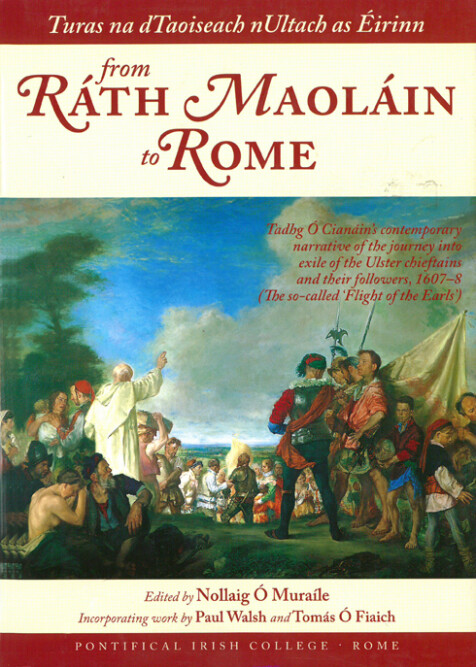Turas na dTaoiseach nUltach as Éirinn from Ráth Maoláin to Rome
Tadhg O Cianáin’s contemporary narrative of the so-called ‘Flight of the Earls’, 1607–8
Nollaig Ó Muraíle
When the principal lords of Gaelic Ulster and their followers sailed from Lough Swilly in September 1607 on the faithful journey that would end in Rome nine months later, their company included one of the Irish learned class – Tadhg Ó Cianáin. This tantalisingly obscure figure has left us a most important primary source for a pivotal period in Irish history.Ó Cianáin’s careful record sheds valuable light on such things as the reaction of the Continental powers – France, Spain, Lorraine, and the Papacy – to the arrival on their territories of the inconvenient Irish exiles; the spread of Tridentine Catholic influence as far afield as Ireland; the role of such important Franciscan figures as Flaithrí Ó Maoil Chonaire and Roibeart Mac Artúir; the palpable Franciscan flavour that suffuses Ó Cianáin’s work; the sights and sounds of the great Baroque city of Rome, and the impressive sophistication and flexibility of the Irish language in accommodating itself to and borrowing from several other languages.
This new edition of Tadhg Ó Cianáin’s work owes much to the two previous editions, those of Paul Walsh (†1916) and Tomás Ó Fiaich and Pádraig de Barra (†1972); from the latter edition it furnishes, in translation, the late Cardinal Ó Fiaich’s invaluable commentary on the Earls’ journey, supplemented by Fr Walsh’s detailed annotation.
Nollaig Ó Muraíle is Senior Lecturer in Irish at the National University of Ireland, Galway. Among his numerous publications are The Celebrated Antiquary: Dubhaltach Mac Fhirbhisigh (c.1600-1671) (1996, 2002); Irish Leaders and Learning through the Ages – a collection of essays by Paul Walsh (2003); and his five-volume edition of Leabhar Mór na nGenealach: The Great Book of Irish Genealogies by Dubhalach Mac Fhirbisigh (2004).

